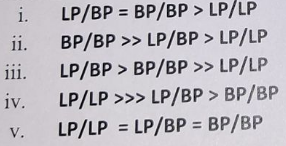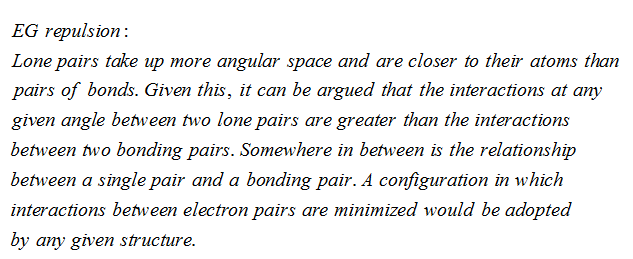h) Looking at the molecular groups for AXs and AX6 in the table on page 3, it can be determined that the order of magnitude for EG repulsion is: LP/BP = BP/BP > LP/LP BP/BP >> LP/BP > LP/LP LP/BP > BP/BP >> LP/LP i. %3D ii. iii. LP/LP >>> LP/BP > BP/BP LP/LP = LP/BP = BP/BP iv. V.
h) Looking at the molecular groups for AXs and AX6 in the table on page 3, it can be determined that the order of magnitude for EG repulsion is: LP/BP = BP/BP > LP/LP BP/BP >> LP/BP > LP/LP LP/BP > BP/BP >> LP/LP i. %3D ii. iii. LP/LP >>> LP/BP > BP/BP LP/LP = LP/BP = BP/BP iv. V.
Chemistry
10th Edition
ISBN:9781305957404
Author:Steven S. Zumdahl, Susan A. Zumdahl, Donald J. DeCoste
Publisher:Steven S. Zumdahl, Susan A. Zumdahl, Donald J. DeCoste
Chapter1: Chemical Foundations
Section: Chapter Questions
Problem 1RQ: Define and explain the differences between the following terms. a. law and theory b. theory and...
Related questions
Question
![The actual structure of SF4 places the lone pair in only one of two possible sites. To discuss the
stability of the observed structures, we need only consider bond angles <120°. Repulsion effects
at angles 2120° are generally ignored. Consider the structure below.
axial
e) If the LP goes into the equatorial position labelled A, there will be
[2/3/4]x 90° angles between the LP and each BP.
OB
equatorial
f) If the LP goes into the axial position labelled B, there will be
[2/314]x 90° angles between the LP and each BP.
equatorial
axial
g) Considering your answers given in e) and f) above.
The most stable arrangement of EGs in SF4 places the LP in the [ axial / equatorial ]
position.
h) Looking at the molecular groups for AXs and AX6 in the table on page 3, it can be
determined that the order of magnitude for EG repulsion is:
i.
LP/BP = BP/BP > LP/LP
ii.
BP/BP >> LP/BP > LP/LP
LP/BP > BP/BP >> LP/LP
LP/LP >>> LP/BP > BP/BP
LP/LP = LP/BP = BP/BP
ii.
iv.
V.](/v2/_next/image?url=https%3A%2F%2Fcontent.bartleby.com%2Fqna-images%2Fquestion%2F655bd7d6-0468-4553-bb81-2f5d532a8e20%2F2f352414-7136-49d6-8dfc-e581b94dc6d2%2Fj00qjhv_processed.jpeg&w=3840&q=75)
Transcribed Image Text:The actual structure of SF4 places the lone pair in only one of two possible sites. To discuss the
stability of the observed structures, we need only consider bond angles <120°. Repulsion effects
at angles 2120° are generally ignored. Consider the structure below.
axial
e) If the LP goes into the equatorial position labelled A, there will be
[2/3/4]x 90° angles between the LP and each BP.
OB
equatorial
f) If the LP goes into the axial position labelled B, there will be
[2/314]x 90° angles between the LP and each BP.
equatorial
axial
g) Considering your answers given in e) and f) above.
The most stable arrangement of EGs in SF4 places the LP in the [ axial / equatorial ]
position.
h) Looking at the molecular groups for AXs and AX6 in the table on page 3, it can be
determined that the order of magnitude for EG repulsion is:
i.
LP/BP = BP/BP > LP/LP
ii.
BP/BP >> LP/BP > LP/LP
LP/BP > BP/BP >> LP/LP
LP/LP >>> LP/BP > BP/BP
LP/LP = LP/BP = BP/BP
ii.
iv.
V.
Expert Solution
Step 1
h)
The given options are,

Step 2

Step by step
Solved in 3 steps with 3 images

Knowledge Booster
Learn more about
Need a deep-dive on the concept behind this application? Look no further. Learn more about this topic, chemistry and related others by exploring similar questions and additional content below.Recommended textbooks for you

Chemistry
Chemistry
ISBN:
9781305957404
Author:
Steven S. Zumdahl, Susan A. Zumdahl, Donald J. DeCoste
Publisher:
Cengage Learning

Chemistry
Chemistry
ISBN:
9781259911156
Author:
Raymond Chang Dr., Jason Overby Professor
Publisher:
McGraw-Hill Education

Principles of Instrumental Analysis
Chemistry
ISBN:
9781305577213
Author:
Douglas A. Skoog, F. James Holler, Stanley R. Crouch
Publisher:
Cengage Learning

Chemistry
Chemistry
ISBN:
9781305957404
Author:
Steven S. Zumdahl, Susan A. Zumdahl, Donald J. DeCoste
Publisher:
Cengage Learning

Chemistry
Chemistry
ISBN:
9781259911156
Author:
Raymond Chang Dr., Jason Overby Professor
Publisher:
McGraw-Hill Education

Principles of Instrumental Analysis
Chemistry
ISBN:
9781305577213
Author:
Douglas A. Skoog, F. James Holler, Stanley R. Crouch
Publisher:
Cengage Learning

Organic Chemistry
Chemistry
ISBN:
9780078021558
Author:
Janice Gorzynski Smith Dr.
Publisher:
McGraw-Hill Education

Chemistry: Principles and Reactions
Chemistry
ISBN:
9781305079373
Author:
William L. Masterton, Cecile N. Hurley
Publisher:
Cengage Learning

Elementary Principles of Chemical Processes, Bind…
Chemistry
ISBN:
9781118431221
Author:
Richard M. Felder, Ronald W. Rousseau, Lisa G. Bullard
Publisher:
WILEY